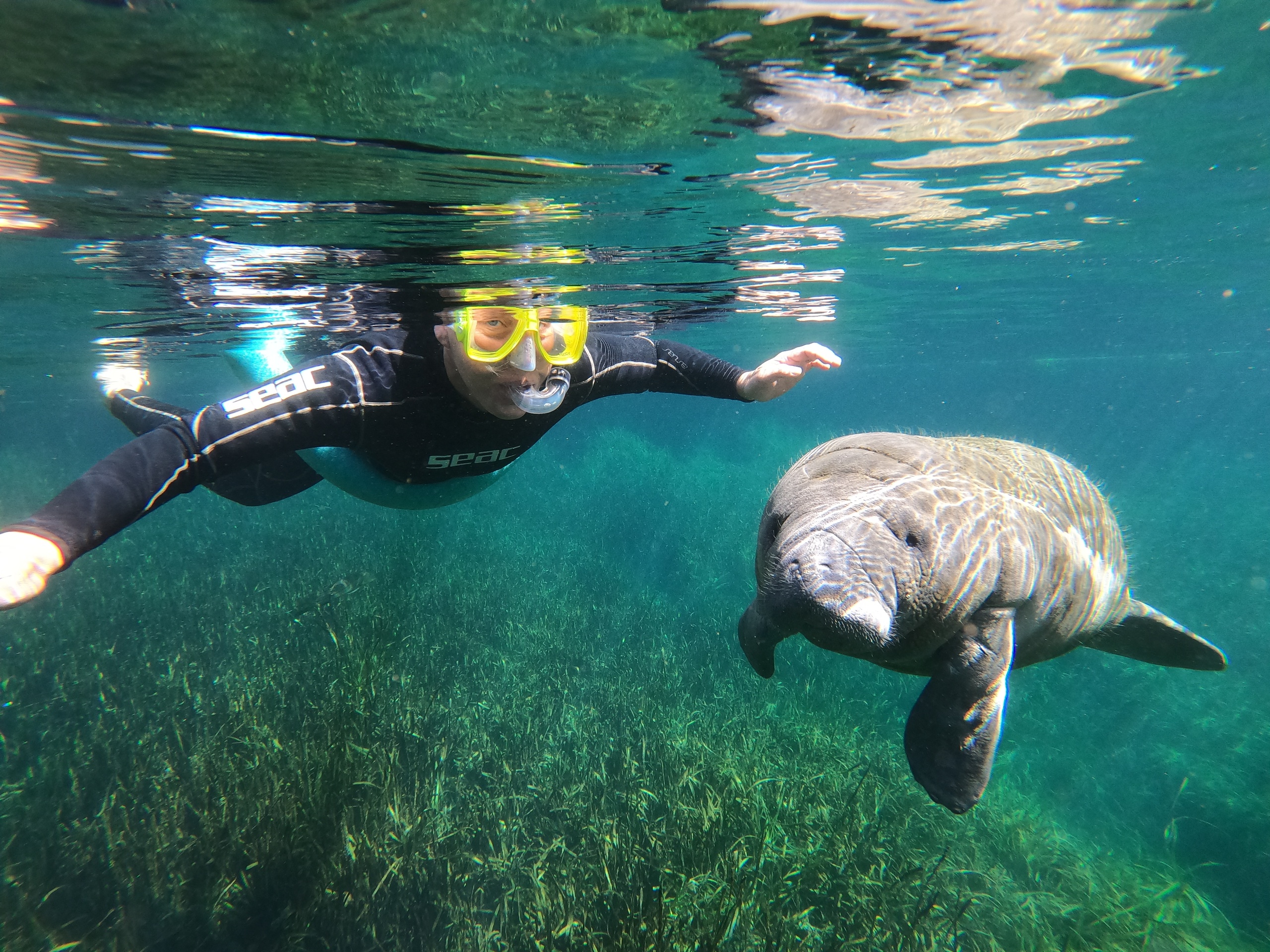Slow Breath, Clear Water: Semi-Private Manatee Snorkeling in Crystal River
NEVER Over Crowded on our Boats • Shared Boats • Beginner to Advanced Snorkelers • 9 Guests Per Boat
Dawn arrives as a soft hush over Kings Bay, the water exhaling a thin, silvery steam into the cool Florida air. The springs hold at a steady 72 degrees, no matter the season, and this morning they behave like patient lungs—steady, certain, welcoming. Your small boat hums out from the dock with just a handful of fellow adventurers aboard, nine guests max, the bay still enough to hear the clink of a mask buckle. Somewhere ahead, the river keeps its own rhythm, and the manatees—those gray, gentle submarines—surfacing with the tempo of their slow, deliberate hearts, invite you into their pace.
Trail Wisdom
Master the slow float
Keep your body flat and motion minimal—slow, quiet movements lead to calmer manatee encounters and clearer photos.
Dress for the dock, not just the swim
Even with a wetsuit, mornings can feel cool; bring a warm layer for the boat ride back, especially in winter.
Protect the springs
Use mineral-based sunscreen sparingly and avoid spraying near the water; better yet, wear a long-sleeve rash guard to limit lotions.
Mind the rules, maximize the magic
Follow passive observation guidelines—no chasing or touching—and you’ll see more natural behavior up close.
Local Knowledge
Hidden Gems
- •Three Sisters Springs boardwalk for a top-down view of crystal-clear vents
- •Crystal River Archaeological State Park’s temple mounds at sunset
Wildlife
West Indian manatee, Osprey
Conservation Note
Respect idle-speed zones, avoid standing on seagrass, and use minimal, mineral-based sunscreen. Follow passive observation rules to reduce stress on manatees.
Crystal River National Wildlife Refuge was established in 1983 to protect critical manatee habitat; Kings Bay’s springs have attracted people and wildlife for millennia.
Seasonal Guide
spring
Best for: Clear water after cold fronts, Quieter crowds
Challenges: Variable manatee numbers, Cool mornings
Shoulder-season calm with lingering winter clarity; sightings can be excellent, especially early in the day.
summer
Best for: Warm air temps, Long daylight
Challenges: Fewer manatees, Afternoon thunderstorms
Manatee numbers dip, but early starts and spring runs still deliver tranquil swims and great visibility.
fall
Best for: Stable weather windows, Gradual return of manatees
Challenges: Hurricane season overlap, Shifting water clarity
As waters cool, manatees drift back in; book flexible dates and go early for the best water.
winter
Best for: Peak manatee counts, Pristine spring clarity
Challenges: Chilly air temps, Higher demand
Prime season. Cold fronts concentrate manatees in spring areas—reserve early and bring a warm layer for post-swim.
Photographer's Notes
What to Bring
Reusable water bottleEssential
Staying hydrated helps you stay warm and comfortable before and after the swim.
Mineral-based sunscreen or rash guardEssential
Protects skin and the spring environment; apply well before entering the water or cover up with fabric.
Warm layer (fleece or insulated jacket)
Air temps can feel chilly after the swim; a cozy layer makes the ride back comfortable.
Action camera with wrist tether
Hands-free video keeps your movements minimal and your photos steady around wildlife.
Common Questions
When is the best time of year to see manatees in Crystal River?
Winter (December–February) is peak season as cold fronts draw manatees into the 72°F springs. Spring and fall can also be excellent with fewer crowds; summer has fewer manatees but still offers clear spring runs.
Do I need to be an experienced swimmer or snorkeler?
No. This tour welcomes beginners. You should be comfortable floating at the surface and using a mask and snorkel; the included wetsuit adds buoyancy and warmth.
Are wetsuits, masks, and snorkels provided?
Yes. Wetsuits, masks, and snorkels are included at no extra charge. Towels and hot showers are available back at the shop.
Can we touch or feed the manatees?
No. Interactions are strictly passive: no touching, chasing, feeding, or cornering. Let the manatees choose the encounter for an ethical, natural experience.
What’s the water temperature and will I get cold?
The springs stay around 72°F year-round. The wetsuit helps, but bring a warm layer for the boat ride, especially in winter.
Is the water calm, and will I get seasick?
Kings Bay is a sheltered, spring-fed system with generally calm conditions, so seasickness is uncommon.
What to Pack
Swimsuit and quick-dry towel: you’ll suit up on site and appreciate drying off fast; Warm layer: winter air can feel cool after a 72°F swim; Reusable water bottle: hydrate pre- and post-boat; Waterproof case for phone/ID: keep essentials safe and dry.
Did You Know
Crystal River National Wildlife Refuge, established in 1983, protects one of North America’s largest wintering populations of West Indian manatees, drawn by springs that remain about 72°F year-round.
Quick Travel Tips
Book the earliest tour for calmer water and fewer boats; Arrive 30 minutes early to get fitted for your wetsuit without rushing; Avoid lotions just before the swim—use a rash guard instead; Build in extra time to visit Three Sisters Springs’ boardwalk after your tour.
Local Flavor
Post-dive, refuel at The Crab Plant for just-off-the-boat seafood with bay views, or sip local at Copp Winery & Brewery. Stroll the Heritage Village for small-town shops, then catch sunset at Fort Island Gulf Beach to close out your springs-to-sea day.
Logistics Snapshot
Closest airports: Tampa (TPA) ~1.5–2 hours, Orlando (MCO) ~2 hours. Launch sites are in Crystal River near Kings Bay; allow 5–10 minutes from most in-town lodging. Cell service is generally good in town and moderate on the bay. No permits required for guided tours; follow U.S. Fish & Wildlife Service rules for manatee encounters.
Sustainability Note
This spring system shelters a federally protected species—pack out all trash, avoid standing on seagrass, use minimal mineral-based sunscreen, and give manatees the right of way.
